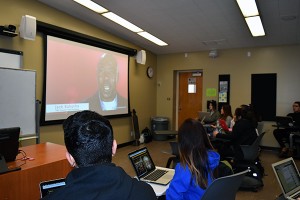
SJSU professors are redesigning lower division math and physics classes that are requirements for science, technology, engineering and math (STEM) majors.
For the next four years, several faculty members in the Charles W. Davidson College of Engineering and the College of Science will be working to transform gateway science, technology, engineering and math (STEM) courses with a $3 million grant from the U.S. Department of Education. San Jose State University is one of 18 colleges and universities in the nation to receive a 2015 First in the World grant.
SJSU faculty members will work with CSU Los Angeles and Cal Poly Pomona representatives on creating flipped classroom materials that will be piloted at all three campuses. At San Jose State, Provost Andy Feinstein and Associate Professor Laura Sullivan-Green, from civil and environmental engineering, are co-directors on the grant. The first courses that will be updated are Math 30 (calculus I) and Phys 50 (physics I). The classes are a requirement for many STEM majors and a prerequisite for upper division work. The SJSU team plans to implement the flipped classroom model in fall 2016. Flipped courses often include richer and more readily accessible online supplemental study materials; more elaborate and interactive homework and self-check instructional materials; and more engaging in-class teaching strategies.
“We all know that innovation can take many forms and as a key part of the Administration’s goal to promote college access and affordability, the First in the World program aims to support a wide range of innovation to improve student success,” said U.S. Secretary of Education Arne Duncan, in a press release. “We are pleased to support these educational leaders who are driving exciting innovations to achieve those goals.”
As part of SJSU’s Four Pillars of Student Success, university leaders are focused on clearing course bottlenecks. Surveys of students revealed that a major challenge to success is course bottlenecks – impasses where they cannot enroll in a course they need to make progress toward their degrees, or when they cannot successfully complete a course and move forward. The university will offer up to 500 additional course sections in 2016-17 to clear bottlenecks. The CSU Chancellor’s Office Proven Course Redesign and Promising Practices grants along with the First in the World grant are targeted at improving successful completion of general education courses that are needed for students to move on to upper division work.
“We are hosting faculty and campus coordinators from our two partner campuses the first weekend in June to facilitate community-building and course material development,” said Sullivan-Green, noting that 30 faculty members and administrators are involved between the three campuses in the First in the World Grant.
